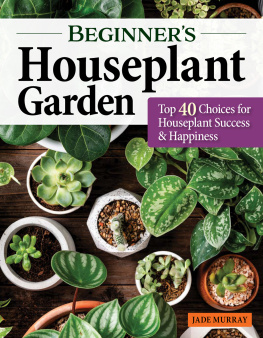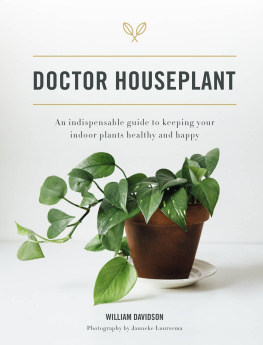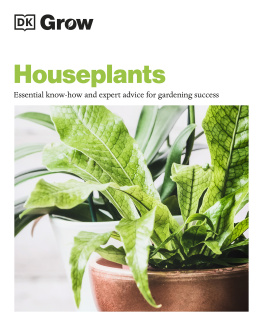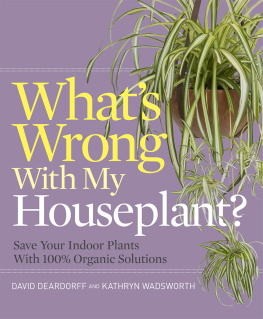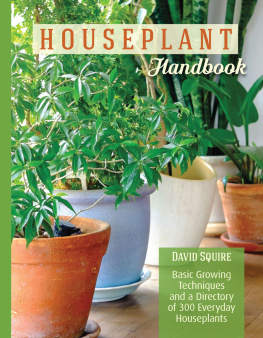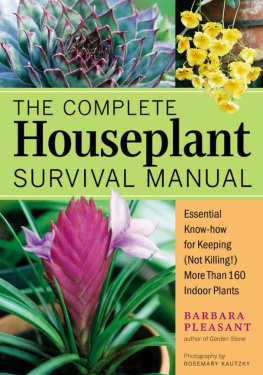THE COMPLETE HOUSEPLANT SURVIVAL MANUAL

THE COMPLETE HOUSEPLANT SURVIVAL MANUAL
ESSENTIAL KNOW-HOW FOR KEEPING (NOT KILLING!) MORE THAN 160 INDOOR PLANTS
BARBARA PLEASANT
PHOTOGRAPHY BY ROSEMARY KAUTZKY
The mission of Storey Publishing is to serve our customers by
publishing practical information that encourages
personal independence in harmony with the environment.
EDITED BY Gwen Steege
TECHNICAL EDIT AND PLANT KEY BY Elizabeth P. Stell
ART DIRECTION AND COVER DESIGN BY Kent Lew
TEXT DESIGN AND PRODUCTION BY Vertigo Design and Cynthia McFarland
PRODUCTION ASSISTANCE BY Jessica Armstrong and Jennifer Jepson Smith
COVER AND INTERIOR PHOTOGRAPHS Rosemary Kautzky, except for those on pages 110, 111, and 192 MACORE, Inc.
ILLUSTRATIONS Christine Erikson
INDEXED BY Stepping Stones Indexing Services
Text 2005 by Barbara Pleasant
All rights reserved. No part of this book may be reproduced without written permission from the publisher, except by a reviewer who may quote brief passages or reproduce illustrations in a review with appropriate credits; nor may any part of this book be reproduced, stored in a retrieval system, or transmitted in any form or by any means electronic, mechanical, photo copying, recording, or other without written permission from the publisher.
The information in this book is true and complete to the best of our knowledge. All recommendations are made without guarantee on the part of the author or Storey Publishing. The author and publisher disclaim any liability in connection with the use of this information. For additional information please contact Storey Publishing, 210 MASS MoCA Way, North Adams, MA 01247.
Storey books are available for special premium and promotional uses and for customized editions. For further information, please call 1-800-793-9396.
LIBRARY OF CONGRESS CATALOGING-IN-PUBLICATION DATA
Pleasant, Barbara.
The complete houseplant survival manual / by Barbara Pleasant ; photography by Rosemary Kautzky.
p. cm.
Includes index.
ISBN 978-1-58017-569-2
1. House plants. I. Title.
SB419.P573 2005
635.965dc22
2005014205
CONTENTS
INTRODUCTION
HOW HOUSEPLANTS EARN THEIR KEEP
PART ONE
BLOOMING HOUSEPLANTS
PART TWO
FOLIAGE HOUSEPLANTS
PART THREE
HOUSEPLANT CARE
APPENDICES

INTRODUCTION
HOW HOUSEPLANTS EARN THEIR KEEP

For the past two centuries, mankind has been playing with houseplants as if they were pretty toys. We have appreciated their beauty and suspected their power to enrich our lives, yet we are only now learning how they also can foster something everyone wants: to feel happy. The science of happiness is still in its infancy, but houseplants, it seems, have been doling out doses of happiness for a long time. And, with the increasing availability of bright blooming houseplants (which get the highest smile ratings), more and more people are discovering the joys to be found in indoor gardening.
We hope you are one of these people. This book is designed to meet the needs of house-plant growers of all skill levels, from newbies, who often feel a bit anxious about doing the wrong thing and causing their plant to suffer, to experienced plant keepers, who sometimes want to know more about a plants background and superior forms that might be available. The plant profiles in .
Before we jump into that green world, a short review of how houseplants came to be is in order, as well as an inventory of the benefits they bring to the people who grow them. When it comes to houseplants, history, healing arts, environmental sciences, and interior design intertwine in unique and life-enhancing ways. Expanding your awareness of what house-plants can do will give you a new appreciation for indoor plants wherever you are lucky enough to encounter them from the waiting room at your dentists office to your own kitchen windowsill.
A Brief History of Houseplants
When did people begin keeping indoor plants? It wasnt so long ago, because people had neither plants nor hospitable indoor environments until modern times. The forerunners to houseplants were medicinal herbs, which monasteries and apothecaries struggled to keep alive in dim, drafty indoor spaces when protected courtyards would not do. The advent of glass windows (which began appearing in Europe in the late 1600s but were not commonplace for another 200 years) were quickly followed by the culture of citrus fruits the first plants to be widely grown under glass in early conservatories. But it was not until plant exploration boomed in the nineteenth century, coupled with the increased availability of window glass, that people had real choices in houseplants and suitable environments in which to grow them. Blown-glass tableware, and even stained glass, predate clear window glass by several hundred years, because forming molten glass into a flat surface is much trickier than creating small pieces or variously shaped bubbles. Its interesting to imagine the excitement people felt when window glass made it possible to enjoy indoor light year-round a huge change from pulling closed dark shutters every time a cold wind blew. The next step was to see if plants could also make use of light that came through wavy glass windows.
Social changes supported the move to grow plants indoors. During the Victorian era (1837 to the early 1900s), a nicely kept formal parlor became a symbol of middle-class respectability, and a proper parlor included plants. Many of these plants remain popular today because of their ability to adapt to low light aspidistra, sanseveria, ferns, and palms. Geraniums also became a fashion craze, and small terrariums planted with tiny tropicals provided the middle class with miniature versions of the glassed-in conservatories kept by the rich. In 1936, George Orwell used the aspidistra as a symbol for the English middle classs preoccupation with propriety in his comic novel Keep the Aspidistra Flying.

Miniature greenhouses, or terrariums, were one of the first methods employed for keeping plants indoors.
Meanwhile, in North America, the first half of the twentieth century was a quiet era for houseplants, but they came back into style with a vengeance in the 1960s and 1970s. As part of the back-to-nature movement, people got into green things again, and a new generation of plants was ready to fill the need. Dorm rooms were decked out with dracaenas and philodendrons, and sparsely furnished apartments became jungles of jade plants, crotons, and cacti. Then, as the flower power generation became more involved in careers, raising families, and keeping up yards, their houseplant collections thinned.
But changes are afoot. The generation that embraced houseplants in the 1970s is rediscovering old green friends and making many new ones. The roles houseplants play in peoples lives have changed, too. Instead of symbolizing social status or the need for a cleaner, greener world, houseplants are valued for all the things they do, from providing companionship to purifying the air to helping fragile bodies heal. We no longer grow houseplants to impress other people. We grow them to please and nurture ourselves.
Next page


